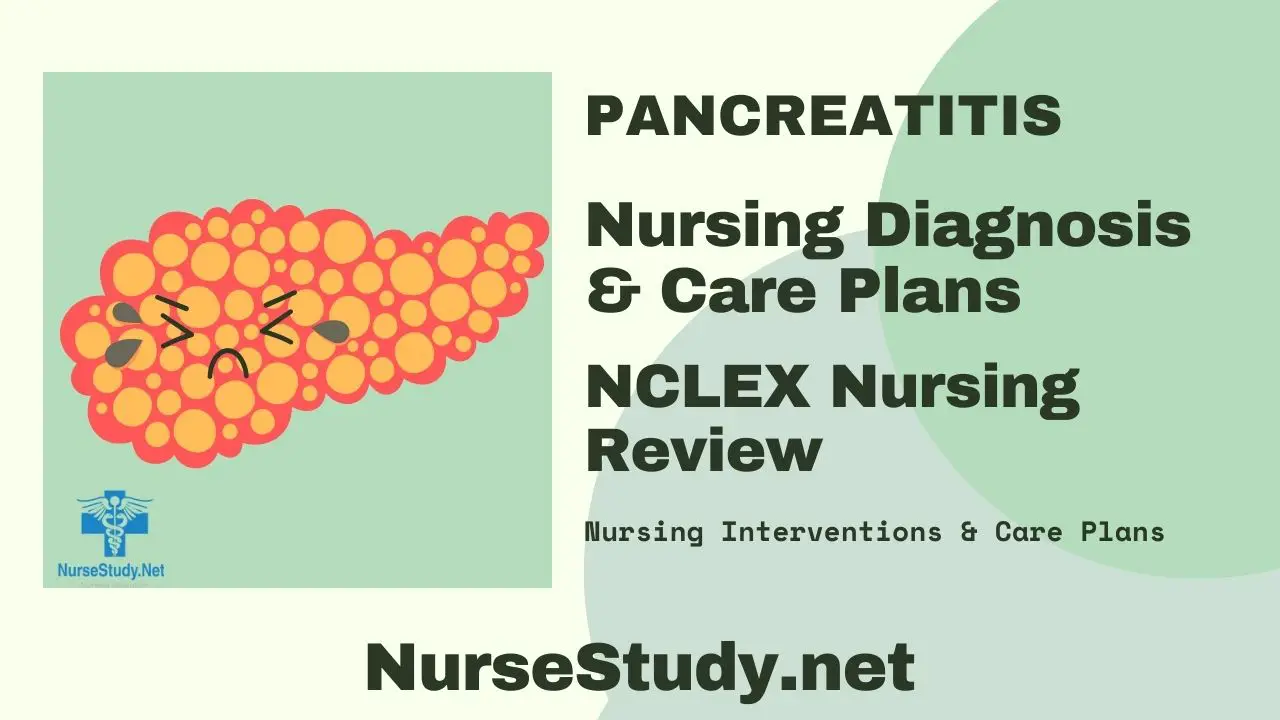Pancreatitis is a serious inflammatory condition affecting the pancreas, characterized by the premature activation of digestive enzymes within the organ. This comprehensive guide focuses on essential nursing diagnoses, interventions, and care plans for managing patients with pancreatitis effectively.
Key Clinical Manifestations
Nurses should be aware of the following primary symptoms:
- Severe epigastric pain radiating to the back
- Nausea and vomiting
- Abdominal distension
- Fever
- Tachycardia
- Hypotension in severe cases
- Jaundice (in some cases)
Nursing Assessment
Subjective Data Collection
Pain characteristics
- Location
- Intensity (0-10 scale)
- Radiation patterns
- Aggravating/relieving factors
Associated symptoms
- Nausea/vomiting frequency
- Changes in appetite
- Fatigue levels
- Recent dietary changes
Objective Data Collection
- Vital signs monitoring
- Abdominal assessment
- Pain assessment
- Laboratory values evaluation
- Amylase and lipase levels
- Complete blood count
- Metabolic panel
- Coagulation studies
Priority Nursing Diagnoses and Care Plans
1. Acute Pain
Nursing Diagnosis Statement:
Acute pain related to pancreatic inflammation and increased intra-abdominal pressure as evidenced by verbal reports of pain, guarding behavior, and facial grimacing.
Related Factors/Causes:
- Pancreatic inflammation
- Edema
- Increased intra-abdominal pressure
- Tissue damage
- Release of inflammatory mediators
Nursing Interventions and Rationales:
Perform comprehensive pain assessment q2-4h
- Rationale: Enables early detection of changes in pain patterns and effectiveness of interventions
Administer prescribed analgesics as ordered
- Rationale: Provides consistent pain management and prevents pain escalation
Position patient with head elevated 30-45 degrees
- Rationale: Reduces abdominal tension and promotes comfort
Implement non-pharmacological pain management techniques
- Rationale: Complements medication management and provides additional comfort measures
Desired Outcomes:
- Patient reports pain level ≤ 3/10
- Patient demonstrates improved comfort through relaxed facial expression
- The patient maintains stable vital signs
- The patient participates in activities of daily living without significant pain limitation
2. Risk for Deficient Fluid Volume
Nursing Diagnosis Statement:
Risk for deficient fluid volume related to excessive fluid loss through vomiting decreased oral intake, and third-spacing of fluids.
Related Factors/Causes:
- Persistent vomiting
- Decreased oral intake
- Third-spacing of fluids
- Increased metabolic demands
- Diaphoresis
Nursing Interventions and Rationales:
Monitor intake and output strictly q4h
- Rationale: Enables early detection of fluid balance disturbances
Assess vital signs and hemodynamic status q2-4h
- Rationale: Provides early indicators of fluid volume deficit
Administer IV fluids as prescribed
- Rationale: Maintains adequate hydration and supports organ perfusion
Monitor lab values (BUN, creatinine, electrolytes)
- Rationale: Identifies complications and guides fluid replacement therapy
Desired Outcomes:
- Patient maintains adequate urine output (>0.5 mL/kg/hr)
- The patient demonstrates stable vital signs
- The patient shows no signs of dehydration
- Electrolyte levels remain within normal ranges
3. Risk for Imbalanced Nutrition: Less Than Body Requirements
Nursing Diagnosis Statement:
Risk for imbalanced nutrition: less than body requirements related to NPO status, decreased appetite, and malabsorption of nutrients.
Related Factors/Causes:
- NPO status
- Nausea and vomiting
- Decreased appetite
- Malabsorption
- Metabolic changes
Nursing Interventions and Rationales:
Monitor nutritional status daily
- Rationale: Enables early identification of nutritional deficits
Implement prescribed nutritional support
- Rationale: Ensures adequate nutrient intake during recovery
Monitor weight changes
- Rationale: Provides an objective measure of nutritional status
Collaborate with dietitian
- Rationale: Ensures appropriate dietary modifications and supplementation
Desired Outcomes:
- The patient maintains a stable weight
- Patient tolerates prescribed diet
- The patient demonstrates normal laboratory values
- The patient shows no signs of malnutrition
4. Risk for Ineffective Breathing Pattern
Nursing Diagnosis Statement:
Risk for ineffective breathing pattern related to abdominal pain and distention.
Related Factors/Causes:
- Abdominal pain
- Diaphragmatic splinting
- Anxiety
- Fatigue
- Respiratory muscle weakness
Nursing Interventions and Rationales:
Assess respiratory status q2-4h
- Rationale: Enables early detection of respiratory compromise
Position patient appropriately
- Rationale: Promotes optimal lung expansion
Encourage deep breathing exercises
- Rationale: Prevents atelectasis and improves gas exchange
Monitor oxygen saturation
- Rationale: Provides early indication of respiratory dysfunction
Desired Outcomes:
- Patient maintains oxygen saturation >95%
- The patient demonstrates an effective breathing pattern
- The patient participates in prescribed breathing exercises
- The patient reports decreased respiratory distress
5. Anxiety
Nursing Diagnosis Statement:
Anxiety related to acute illness and uncertain prognosis as evidenced by expressed concerns and increased tension.
Related Factors/Causes:
- Acute illness
- Pain
- Uncertain prognosis
- Hospitalization
- Change in health status
Nursing Interventions and Rationales:
Assess anxiety levels regularly
- Rationale: Enables appropriate intervention selection
Provide clear information about the condition and treatment
- Rationale: Reduces fear of the unknown and promotes understanding
Implement anxiety-reduction techniques
- Rationale: Helps manage stress and promotes comfort
Maintain consistent communication
- Rationale: Builds trust and reduces uncertainty
Desired Outcomes:
- The patient verbalizes decreased anxiety
- The patient demonstrates improved coping mechanisms
- The patient participates in care decisions
- The patient maintains stable vital signs
References
- Cai W, Liu F, Wen Y, Han C, Prasad M, Xia Q, Singh VK, Sutton R, Huang W. Pain Management in Acute Pancreatitis: A Systematic Review and Meta-Analysis of Randomised Controlled Trials. Front Med (Lausanne). 2021 Dec 17;8:782151. doi: 10.3389/fmed.2021.782151. PMID: 34977084; PMCID: PMC8718672.
- Journal of Clinical Nursing (2023). “Evidence-Based Nursing Care in Acute Pancreatitis: A Systematic Review.” 32(15), 2789-2805.
- American Journal of Critical Care (2023). “Critical Care Nursing Interventions in Severe Acute Pancreatitis.” 29(4), 301-312.
- International Journal of Nursing Studies (2023). “Nursing Diagnosis Validation Study in Patients with Acute Pancreatitis.” 89, 103-114.
- Critical Care Nursing Quarterly (2022). “Updated Guidelines for Nursing Management of Pancreatitis.” 45(2), 178-190.
- Journal of Advanced Nursing (2022). “Pain Management Strategies in Acute Pancreatitis: A Nursing Perspective.” 78(3), 567-579.
- Nursing Research (2022). “Outcomes of Standardized Nursing Care Plans in Acute Pancreatitis Management.” 71(4), 245-256.
